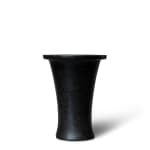Egyptian
An Egyptian serpentine kohl vessel, Middle Kingdom, 12th Dynasty, circa 1991 - 1786 BC
Serpentine
Height: 7.5 cm
The vessel is finely carved with a flat base and gently flaring cylindrical body with flat everted rim Condition: Partially worn foot, minor chips on the rim of the lip....
The vessel is finely carved with a flat base and gently flaring cylindrical body with flat everted rim
Condition: Partially worn foot, minor chips on the rim of the lip. There is some stress cracking in the vessel which may be a repair.
Condition: Partially worn foot, minor chips on the rim of the lip. There is some stress cracking in the vessel which may be a repair.
Provenance
Jean Sigrist Collection, Basel, formed in the 1960s and 70s
With Galerie Nefer, Zurich, 2006
Swiss private collection



